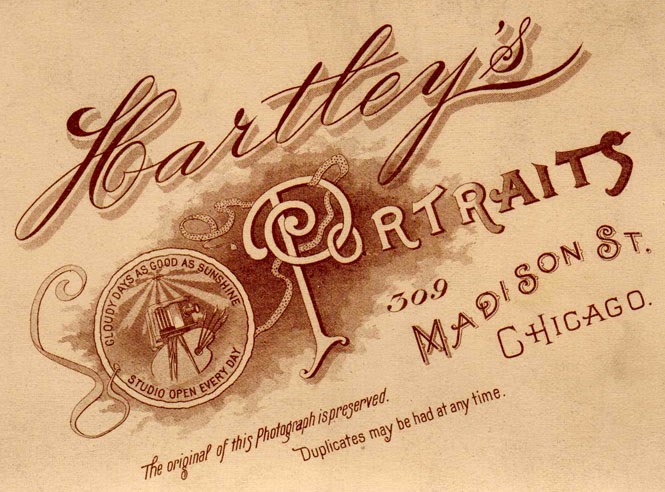On February 2, 1897, Frances Glessner wrote the following in her
journal:
“I went to Hartley’s
on West Madison St. and had my photograph taken – a multigraph.”
Fortunately this most unusual photograph is part of the museum
collection. In this article, we will
look briefly at Hartley’s and then at the interesting process by which these
photographs were taken.
Hartley’s Studios opened in Chicago in 1877. According to an advertisement published in
the Chicago Tribune on January 5,
1890, “Hartley’s Studios are the largest and finest in the United States, and
nothing but first-class work allowed to leave the studios.” That same advertisement featured their
trademark rooster with the following riddle – “Why is Hartley’s Rooster the
Smoothest Bird of His Kind? – Because He Always Carries His COMB with Him.” This was followed by a poem which read in
part:
“With resonant Crow
and hearty good cheer,
Our Rooster would
welcome another New Year!
Still armed, as you
see, with powder and gun,
And joyously Crowing
o’er victories won!
The hearts of his
foes were hateful and flinty,
But have met the sad
fate that befell poor McGinty!
Many thanks to our
patrons, may abundance of Cheer
Fill every hour of this
Happy New Year.”
Chicago Tribune, February 5, 1893
The studio was located at 309 W. Madison Street, using the old street
numbering system in place at the time.
In 1909, that address was changed to 1044 W. Madison Street, which would
have placed the studio less than two blocks away from the Glessners’ former
home at Washington and Morgan streets.
It is not surprising that a large and prominent studio such as Hartley’s
would have embraced the novel new multigraph method of photography for its
customers. The process appears to have
originated about four years before Frances Glessner had her photograph made,
the first known reference appearing in a scientific journal in October
1893. A year later, the Scientific American published an article
which included several illustrations, including the one below, clearly showing
how the image was captured. The subject
sat facing two mirrors set at an angle of about 75 degrees to each other. This resulted in five views of the sitter
being captured simultaneously on the negative.
Scientific American, October 6, 1894
The image shown at the top of the article beautifully captures Frances
Glessner’s distinctive hairstyle, one which she maintained consistently
throughout her married life, at the request of her husband. Given that the multigraph photo captures her
from behind and from both sides, we are clearly able to see exactly how the
hair was positioned, and the hair ornaments that were used. She opted for a second photo, shown below,
which captures her wearing her coat and hat, the latter sporting a jauntily
placed bird.
Together, these two images captured interesting and unique views of
Frances Glessner and also afforded her the opportunity to see herself as others
saw her.
For more information on multigraph photography, see “A Multigraph from Montreal,” written by Irwin Reichstein for the May-June 2007 issue of Photographic Canadiana. The article contains several illustrations
showing humorous uses for this photographic novelty.






No comments:
Post a Comment